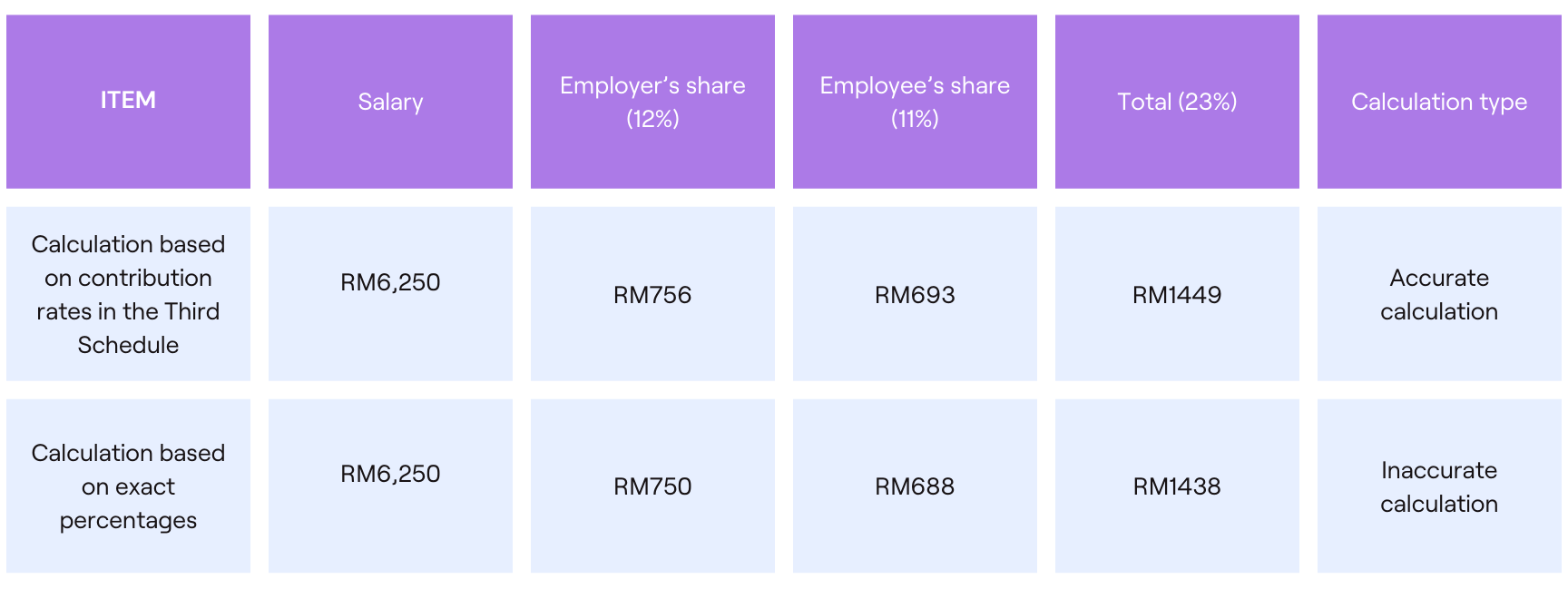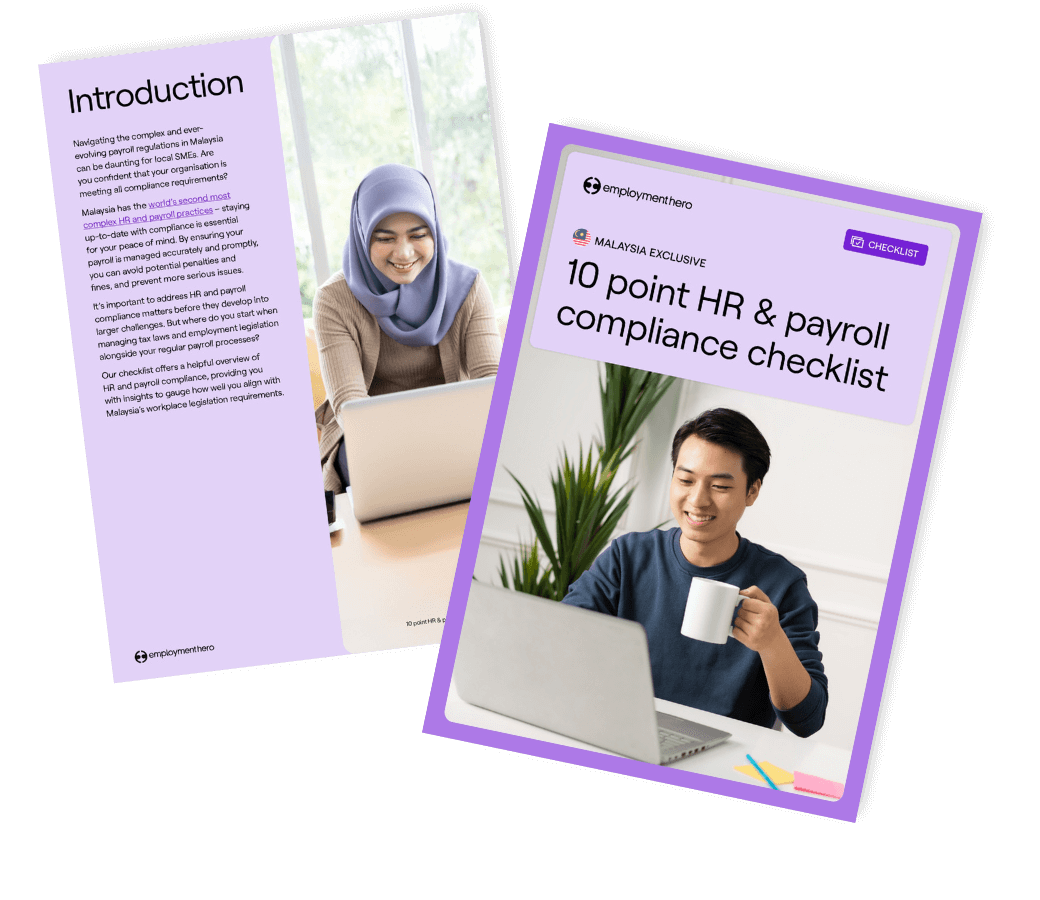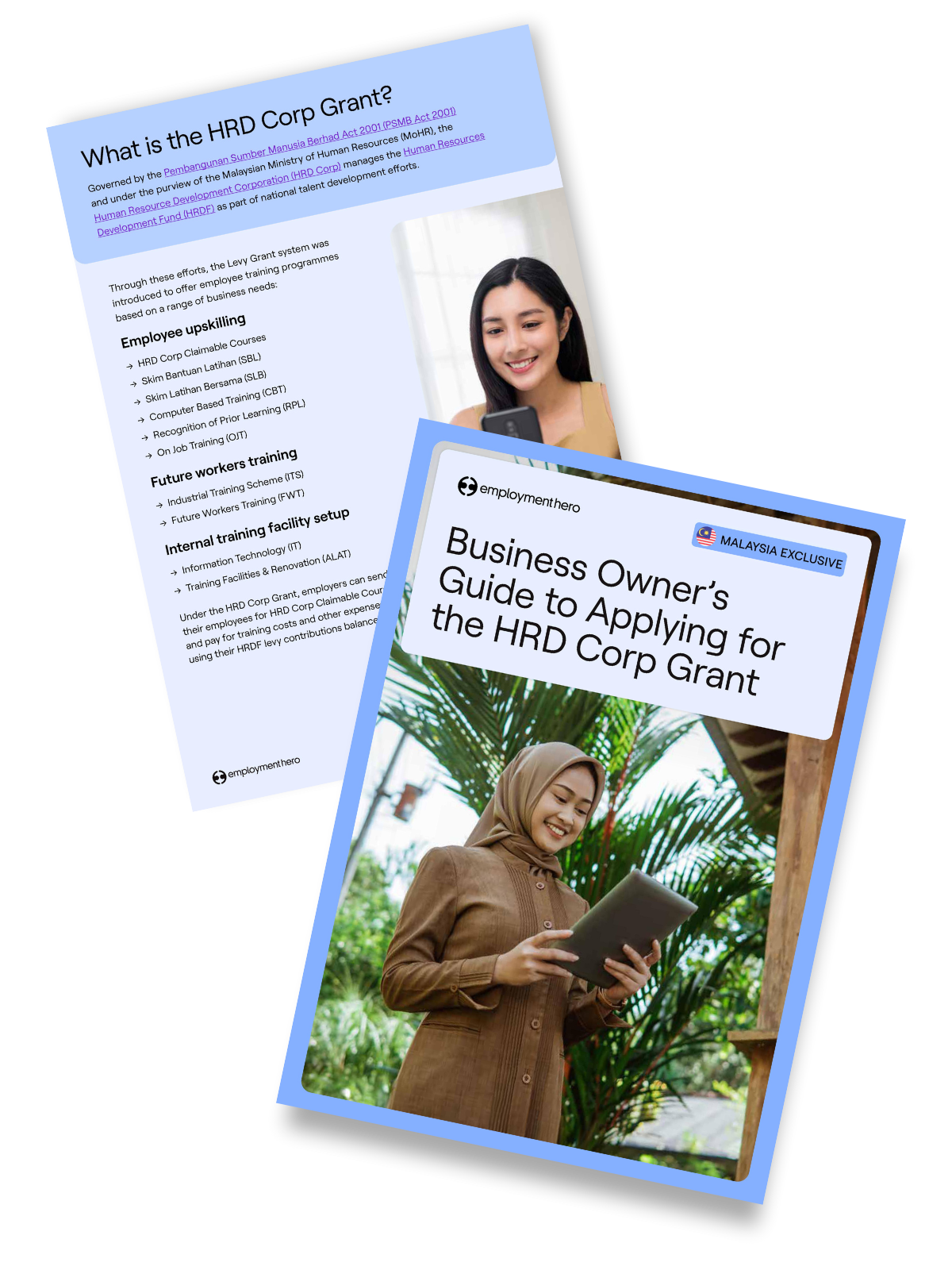Malaysia Payroll Tax: Employer FAQs Answered
Published
Malaysia Payroll Tax: Employer FAQs Answered
Mention payroll regulations, and the first words that come to mind are probably ‘complex’, ‘complicated’, and ‘confusing’. As an employer, it’s stressful to constantly keep up with changing legislation and maintain compliance.
We’re here to help. With global economic uncertainty, rising inflation rates and the skyrocketing cost of living, there’s never been a more important time for Malaysian businesses to make sure their employees are paid compliantly.
With key dates just around the corner (for example, employers need to prepare and disseminate EA Forms to their employees before the end of February), we want you to feel confident when it comes to paying your taxes in line with Malaysian legislation.
In this free factsheet we answer the most frequently asked questions that SMBs have when it comes to payroll and tax.
It covers;
- What you need to submit to the Inland Revenue Board (IRBM/LHDN)
- What you need to submit to the Employees Provident Fund (EPF)
- What you need to submit to the Social Security Organization (SOCSO)
- What you need to submit to the Human Resources Development Corporation (HRD Corp)
- What forms you need to disseminate to employees
- Key dates and details for all of the above!
Disclaimer: The information in this report is relevant as at 9 Feb 2023, and has been prepared by Employment Hero Pty Ltd ABN (11 160 047 709) (Employment Hero). The views expressed herein are general information only and are provided in good faith to assist employers and their employees. The Information is based on data supplied by third parties. While such data is believed to be accurate, it has not been independently verified and no warranties are given that it is complete, accurate, up to date or fit for the purpose for which it is required. Employment Hero does not accept responsibility for any inaccuracy in such data. To the maximum extent permitted by law, Employment Hero will not be liable to any party in contract, tort (including for negligence) or otherwise for any loss or damage arising either directly or indirectly as a result of reliance on, use of or inability to use any information provided in this report. Where liability cannot be excluded by law then, to the extent permissible by law, liability is limited to the resupply of the information or the reasonable cost of having the information re-supplied. If you are unsure about how this information applies to your specific situation, we recommend you seek expert advice for your personal situation or find more information at malaysia.gov.my.
Download your copy of our factsheet now using the form to the right! Or read on below for basic information about payroll tax.
What is the Year of Assessment (YA) in Malaysia?
The year of assessment in Malaysia runs from 1st January to 31st December, same as the calendar year. It refers to the year in which income tax is calculated and charged, based on the income from that financial year.
When is the income tax filing deadline for Malaysian employers?

Monthly income tax deadline
Employers are responsible for submitting a monthly withholding tax return. You will have to make monthly tax deduction payments to the Inland Revenue Board of Malaysia by the 15th of the following month. This is known as the CP39 statement.
Annual income tax deadline
Employers are required to submit Form E to IRBM by 31st March 2023, to report annual returns to the government for all employees.
Download the factsheet for a complete list of all the deadlines you need to be aware of.

How can employers prepare for the tax period?
Here’s what employers should do to prepare for the busy tax period.
1. Ensure your employees’ details are accurate and up-to-date
There’s nothing more frustrating than running into errors when you’re submitting your tax file to the Inland Revenue Board of Malaysia (IRBM/LHDN). Especially when such errors can be easily avoided. It’s important to ensure you aren’t missing any employee’s address or personal details, which are mandatory for tax filing purposes.
If you have a payroll software like Employment Hero that enables employee self-service, that would make things so much more fuss-free and convenient. Employees can easily login to the platform to make changes whenever needed, and these updates will be reflected across the entire system. You’ll never encounter missing information when submitting your tax returns again.
2. Be familiar with the tax forms that need to be submitted
There are various income tax return forms that need to be submitted to the IRBM/LHDN during tax season — you’ll find tax processing less of a chore if you’re familiar with what forms are needed and what they’re for.
These include Form E, Form EA, Form STD/PCB(II), and more.
3. Have a checklist of all the employer obligations you need to fulfil
With so many items on your to-do list once tax season rolls around, it’s best to stay on top of everything with a handy checklist. You definitely don’t want to be incurring a fine or imprisonment term due to non-compliance.
Here’s a recommended checklist for you:
- Register employer file number
- Submit employer return form (Form E)
- Declare new employees
- Issue income statement to employees (Form EA/EC)
- Double check any employee’s details which have been newly updated
- Complete monthly tax deductions and send to IRBM/LHDN
- Notify employees to submit TP1 form (claim of deduction/rebate for individuals) and TP3 form (previous employment information in current year)
- Keep records of all documentation for 7 years
- Withhold any money payable to an employee for 90 days or until a tax clearance letter is received, in the case of cessation of employment, cessation by reason of death, or if the employee is leaving Malaysia for more than 3 months with no intention of returning
What do employers need to consider when paying income tax?
There are mandatory statutory contributions alongside the monthly tax deduction that employers need to be familiar with.
Monthly Tax Deduction (MTD)
Employers are required to make a monthly tax deduction (MTD) directly from an employee’s salary — it is also referred to as Potongan Cukai Bulanan (PCB). Employers need to pay this tax amount to the Inland Revenue Board of Malaysia (IRBM/LHDN) on the employee’s behalf on or before the 15th of the next month.
Social Security Organisation (SOCSO)
The Social Security Organisation (SOCSO) manages social security funds in Malaysia, and was created with the aim of providing social security protection to Malaysians. It comprises two social protection schemes — the Employment Injury Insurance Scheme, and the Invalidity Pension Scheme.
SOCSO contributions are mandatory for all employees, regardless of whether they are a Malaysian citizen, permanent resident, or foreign worker.
Employers are required to contribute monthly on behalf of each eligible employee, and employee contributions must be deducted from an employee’s wage, in line with rates outlined in the Employees’ Social Security Act (1969).
The contribution rates are split into two categories — and depend on the employee’s age (whether they are older or younger than 60), and their rate of pay.
Employees Provident Fund (EPF)
The Employees Provident Fund (EPF) is a government fund aimed at assisting Malaysians in saving for their retirement, in accordance with the Employees Provident Fund Act (1991).
EPF payments are only applicable to citizens and permanent residents, and optional for foreign workers. These payments are to be deducted from the employee’s salary, and paid to the EPF by the employer on the employee’s behalf. Employers must also separately make their own EPF contributions on behalf of each eligible employee.
You can find the EPF contribution rates here.
Employment Insurance Scheme (EIS)
Another contribution that must be deducted from an employee’s wage is the Employment Insurance Scheme (EIS). It applies to most Malaysian citizens and permanent residents, with the exception of government employees, domestic workers, those who are self-employed, and employees aged 57 and above who have no prior contributions before the age of 57.
Contribution rates to the EIS are set at 0.4% of the employee’s assumed monthly salary. 0.2% will be paid by the employer while 0.2% will be deducted from the employee’s monthly salary. Contribution rates are capped at an assumed monthly salary of RM4000.
Managed by the Social Security Organization (SOCSO), the EIS is designed to support employees if they lose their job. Workers who become unemployed can access up to 6 months of support through the scheme as they seek new employment.
Human Resources Development Fund (HRDF)
The Human Resources Development Fund (HRDF) levy is a mandatory contribution if you employ ten or more people, established under the Human Resources Development Act 1992. Firms with 10 or more local employees are obligated to register, while firms with 5 to 9 local employees have the option to register. This fund supports the training and upskilling of employees, apprentices and trainees in the Malaysian workforce.
The HRDF levy rate for each Malaysian employee is calculated as a percentage of each employee’s total monthly wages, inclusive of fixed allowances. Other variable allowances such as travel allowance, petrol allowance, parking allowance or internship allowance should not be included.
The HRDF levy rates are 1% of each employee’s monthly wages if a company employs 10 or more Malaysian employees. Exceptions apply — employers of domestic servants are not required to pay the levy.
According to HRDF regulations, once your company reaches 10 Malaysian employees, you must continue contributing at 1% for the whole calendar year — even if your headcount falls to fewer than 10 employees during the year.

What is the tax rate for payroll in Malaysia?
The income tax rates in Malaysia are dependent on an employee’s residence status. This is determined by the time spent in Malaysia, and not their nationality or citizenship.
Tax rates for non-resident employees
Non-resident employees are taxed at a flat rate of 30%. They are also not entitled to any of the tax reliefs enjoyed by residents.
Exemptions apply — individuals will not be subject to these income tax rates if:
- They are employed in Malaysia for fewer than 60 days;
- They are employed on board a Malaysian ship;
- They are aged 55 or over and receiving pension from Malaysian employment;
- They are a non-resident director of a Malaysian company;
- They are a public entertainer;
- Their income comes from interest received from banks; or
- Their income comes from tax-exempt dividends.
Tax rates for resident employees
Resident employees will be taxed at a graduated rate of 0% to 30%, depending on their income. The first RM5,000 earned is tax free. Any income above that amount is subsequently taxed on a progressive basis.
Resident employees will also be able to claim tax reliefs such as personal and family deductions, rebates, etc which will reduce their taxable income.
You can find the full list of personal income tax rates imposed by the Inland Revenue Board here.
Common payroll mistakes that Malaysian employers make
1. Paying employees their wages late
According to the Employment Act 1955, employers are required to payout monthly wages to employees by the 7th day of the following month, or earlier. Employees can file a complaint with the Labour Department if they do not receive their salary payments on time.
The department will then launch an investigation based on the supporting documents provided, and escalate it to the Labour Court if both parties are unable to come to an agreement on the claim.
2. Miscalculation of payroll deductibles like EPF
It is a pretty common mistake for employee provident fund contributions to be calculated wrongly. This is because the amount should not be calculated based on the exact percentage of the employee’s salary, but rather, based on the contribution rates outlined in the Third Schedule of the EPF Act 1991.
Here’s an example of an accurate and inaccurate calculation:

The only exception where employers can use exact percentages to calculate an employee’s EPF contribution amount, is if the employee is earning more than RM20,000 per month. The total amount which includes cents should then be rounded up to the nearest ringgit.
3. Miscalculation of overtime payment
Under the Employment Act, employees with wages of up to RM4,000/month are entitled to overtime compensation. Any hours of work carried out in excess of the normal hours of work per day will be classified as overtime work.
However, it can be easy to miscalculate overtime payments due to the different rates that apply, which depend on whether the overtime hours are during a normal work day, rest days or public holidays.
4. Error in employees’ information
The status of employees changes from month to month, with regards to their salaries, job levels, allowances, deductions, tax rates and more. It can be hard to keep track of changes across an SME or a huge organisation if manual processes are still in place. Without the latest updates and information, there will likely be mistakes in payroll processes so clear and timely communication is key.
5. Misclassification of employees
Classifying employees accurately can be confusing especially when the organisation comprises full-time employees, part-time employees, temporary employees, and independent contractors. They are also paid differently and with varying frequencies — some are paid a fixed amount monthly while others are paid hourly or based on the amount of work done.
6. Inadequate record keeping
If you’re still using old school files and paperwork for bookkeeping, it’s time to change things up. All this information can be easily misplaced, incorrectly filed, or even exposed to the wrong parties, which could leave you open to liability if you were to be audited.
Record keeping is now made easy with digital tools. There’s no need to sift through cupboards and drawers looking for a particular employee file — everything’s accessible in just a few clicks. You’ll never have to deal with lost information ever again either. With so many software options available, there’s no excuse for having incorrect records.
How can payroll software help streamline payroll processes?
Ensuring payroll compliance can be a tedious task, but it doesn’t have to be. A payroll software like Employment Hero can make all the difference.
It’s fully integrated with the LHDN, which means you can pay your people faster than ever, with automated payroll. Get accurate calculations for the entire payroll process, all within minutes. Here are some of the key features on the platform that will transform your business.
Automated payroll
Thanks to the power of automation, completing your payroll process is incredibly easy. All deductions and contributions are automatically calculated for you as per Malaysia’s legislation. This includes EPF, SOCSO and EIS contributions, as well as monthly income tax (MTD/PCB) deductions.
If any changes are made to incentives, bonuses, allowances and more, these deductions are also automatically adjusted. The final calculations will then be displayed for the administrator during the pay run, providing full transparency and streamlined processes for a final review.
With Employment Hero, you can automate payroll to minimise the occurrence of human error in calculations, and free up much more time to focus on important matters.
Time and attendance
Paying part-time employees based on the hours worked is always a tedious process involving lengthy calculations. But Employment Hero helps to eliminate all that pain by helping you keep track of their hours efficiently.
From dynamic rostering to shift bidding, clocking in and out remotely via the mobile app, timesheet submission and more, you can accurately process all the time worked and generate their salary payments as well as payslips accordingly and accurately.
Employee payslips

Generating each employee’s payslip doesn’t have to be an arduous task anymore. With Employment Hero, you can set up automated emails so employees are immediately notified once their payslips are ready to be downloaded.
In addition, digital copies of the payslips are always available to them on the platform under their profile. They can easily access and refer to them anytime they like, wherever they are — even through their phones via the mobile app.
Staying up to date
As you probably already know, there have been multiple changes recently with the Employment (Amendment) Act (2022). Understanding and complying with the EA is one of the biggest challenges facing SMEs, but there’s where Employment Hero comes in.
We have all the contribution rates and deductions built-in, so you never have to worry about manual calculations again. Our experts also keep up to date with legislative changes, and automatically update the platform once these changes are implemented.
Record keeping
When you use Employment Hero, digital records are instantly created and stored in the cloud. This means you’ll never lose a payslip again, and have access to documents in the system anywhere and anytime. Not only does it help you cut down hours of admin, you’ll also never have to worry about record keeping properly again — the platform does it all seamlessly for you.
Monthly and annual reporting
And to the most important part of all — monthly and annual reporting. When it comes to tax reporting, you can compile all the data you need electronically and generate accurate reports in just a few clicks.
Select the dates you want, the employees involved, and the format you’d like the report to be generated in — do you want it in csv, pdf, or txt format? They’re all available and you can export them in an instant for submission to the relevant government bodies.
You can even choose to generate reports in bulk. Report Packs are a bundle of reports that can be generated at any time, or sent to a list of email recipients either at specific times (ad hoc) or on a recurring schedule, as specified by the user.
From expense reimbursement reports to benefits-in-kind reports, have all the data you need right at your fingertips with Employment Hero.
Download the factsheet for more FAQs on running payroll in Malaysia
Payroll isn’t easy, we hear you. If you’re still confused about monthly contributions, or are still unsure about when to pay tax in Malaysia, download our factsheet to find out all the answers you need.
Keen to learn more about our Malaysian payroll system? Book a demo with one of our business specialists now.
Other helpful resources:
Learn more about Employment Hero Payroll. Book a demo with one of our local business specialists today!
Related Resources
-
 Read more: 10 point HR and payroll compliance checklist
Read more: 10 point HR and payroll compliance checklist10 point HR and payroll compliance checklist
Get peace of mind with our 10 point HR and payroll compliance checklist.
-
 Read more: Business Owner’s Guide to Applying for the HRD Corp Grant
Read more: Business Owner’s Guide to Applying for the HRD Corp GrantBusiness Owner’s Guide to Applying for the HRD Corp Grant
Find out if you are eligible for the HRD Corp Grant and how to apply for it here.









